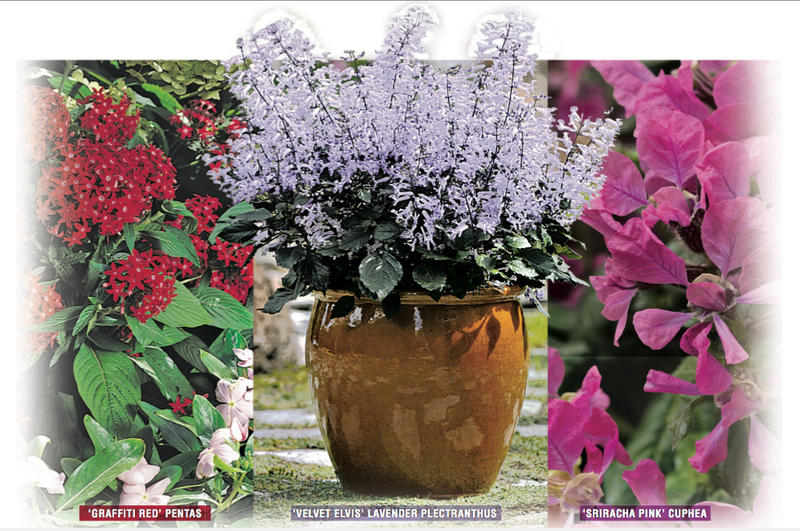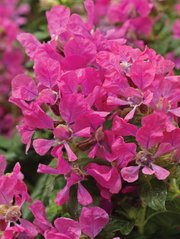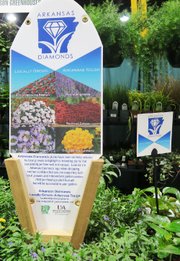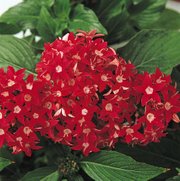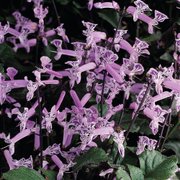Back in garden centers for a second year, the blue Arkansas Diamonds logo is designed to help gardeners choose good annual plants for their summer gardens.
Plants that carry the logo are locally grown and Arkansas tough.
Six plants were awarded the logo in 2015. For 2016, three more flowering summer annuals have been added to the program.
The Diamonds program is a partnership between the Arkansas Green Industry Association, the University of Arkansas Cooperative Extension Service, growers and independent garden centers to educate consumers about plants that thrive in our conditions so they will have more success in their gardens.
Plants chosen for the program grow well statewide with few pest problems. While the same varieties can be found in many markets from various suppliers, shoppers can be certain that those bearing the Diamonds logo are produced in-state by Arkansas growers.
The three new Diamonds include two sun lovers -- "Graffiti Red" Pentas and "Sriracha Pink" Cuphea -- and the shade-loving "Velvet Elvis" Plectranthus.
GRAFFITI RED
Pentas have been a standard summer annual for years. With clusters of star-shape flowers in shades of red, pink, purple or white, they bloom all summer long with little care.
Graffiti Red is a newer, compact variety with bright red flowers. The plant grows up to 10 inches tall. It has a very uniform growth habit and rarely needs pinching. It will do well in containers or mass-planted in the ground.
It needs at least six hours of sun and will take more.
As with most annual plants, regular fertilizer will keep it blooming at peak performance. While not water-needy, regular watering will keep it looking its best.
This plant is a favorite of butterflies and hummingbirds.
SRIRACHA PINK
Many gardeners are unfamiliar with the name Cuphea but do know the annual called Mexican heather, which is a Cuphea.
All members of this genus are extremely drought tolerant, but while Mexican heather bears many tiny blooms, Cuphea "Sriracha Pink" has almost quarter-size blossoms, producing a dramatic display.
Like the spicy chili sauce for which it is named, Sriracha Pink adds a lot of color with large, wide-open pink blooms from late spring through fall. The hotter summer gets, the better it performs.
The plant grows 24-30 inches tall and wide and works well in containers or planted in the ground. Once established, it is very drought tolerant.
VELVET ELVIS
Seeing a name like Velvet Elvis, who wouldn't want to try this plant?
Plectranthus is the genus containing the old-fashioned houseplant Swedish ivy, which is grown primarily for its green foliage. This newer Plectranthus has lovely foliage -- deep green leaves with a deep purple shade underneath -- but it also has beautiful
purple blooms all summer in light shade.
Velvet Elvis is an early blooming variety with large spikes of lavender-blue flowers that open from early spring through fall. The plant has an upright growth habit, maturing at 18 to 24 inches tall and wide.
It is great in containers or in mass plantings in the shade garden.
STILL SPARKLING
The new choices for 2016 are not replacing last year's crop of Diamonds -- they are simply adding to the mix. The plants given the thumbs up as Diamonds in 2015 are "Red Dragon Wing" begonia, purple angelonia, "Cora Cascade" polka dot vinca, "Redhead" coleus, blue scaevola and gold/yellow lantana.
Here is a quick recap of their attributes.
• Red Dragon Wing begonia is a great all-season bloomer. This plant does best in full morning sun with protection from the hot afternoon sun or in filtered sunlight. Give this plant room to grow since it does become 2 to 3 feet tall -- and wide -- by the end of the growing season.
• Angelonia or summer snapdragon is another great summer performer in full sun to partial shade. These spike-forming blooms will continue all summer provided they get regular fertilization. It is very heat- and drought-tolerant but will bloom best if given some water in dry weather. Mature size will vary by variety, but angelonias range between 1 and 3 feet tall and spread 6 to 12 inches.
• Cora Cascade polka dot vinca is an annual periwinkle. While it grows only 6 to 8 inches high, Cascade spreads 32 to 36 inches wide, flowering from frost to frost. The blooms are very evenly distributed, eliminating the "bald spots" that plague some vincas. Large white to pale pink flowers with a red center bloom on a plant with glossy, dense, green foliage. This plant thrives in full sun and is quite drought tolerant. This series is also very disease resistant.
• Redhead coleus ranks among the deepest red of any of the coleus plants on the market. Although it will grow in full sun, it would benefit from a bit of shade in the hottest part of the day, unless you can keep it well watered. It can also do well in partial shade. The mature plant can be 2 feet tall and wide.
• Blue scaevola or fan flower is another full-sun bedding plant that will tolerate partial shade. The fan-shaped flowers are produced all season on low, spreading plants. It is heat and drought tolerant. The plant grows 8-10 inches tall with a spread of 12-24 inches depending on variety.
• Lantanas are one of the most heat-tolerant bedding plants we have for Arkansas gardens. In southern Arkansas, these plants are perennials, but in central Arkansas they are hit and miss. In the northern tier, they are annuals. Size can vary tremendously by variety, but they all thrive in full sun and warm conditions. Although they often can survive on their own, in the hottest, driest months, they appreciate a little water.
Arkansas Diamonds are sold by independent garden centers. To find a list of retailers supporting the program, visit argia.org.
Janet B. Carson is a horticulture specialist for the University of Arkansas Cooperative Extension Service.
HomeStyle on 04/16/2016
